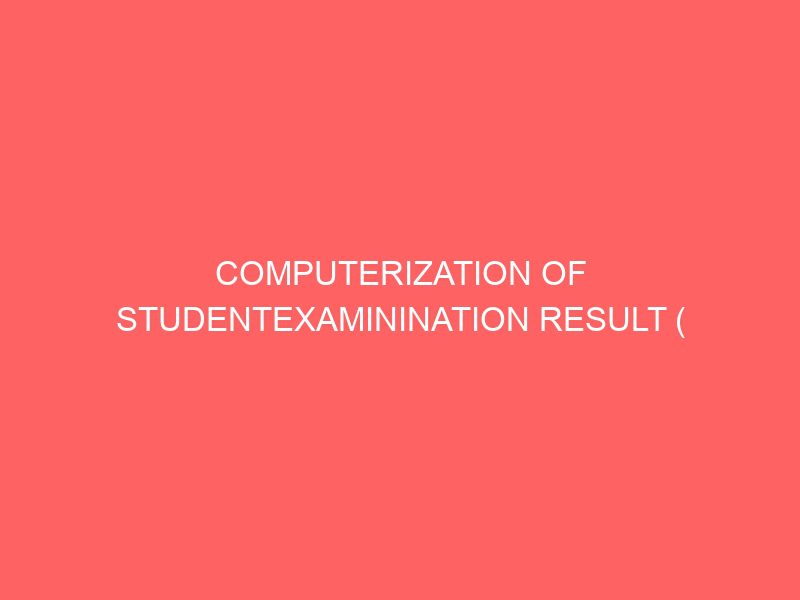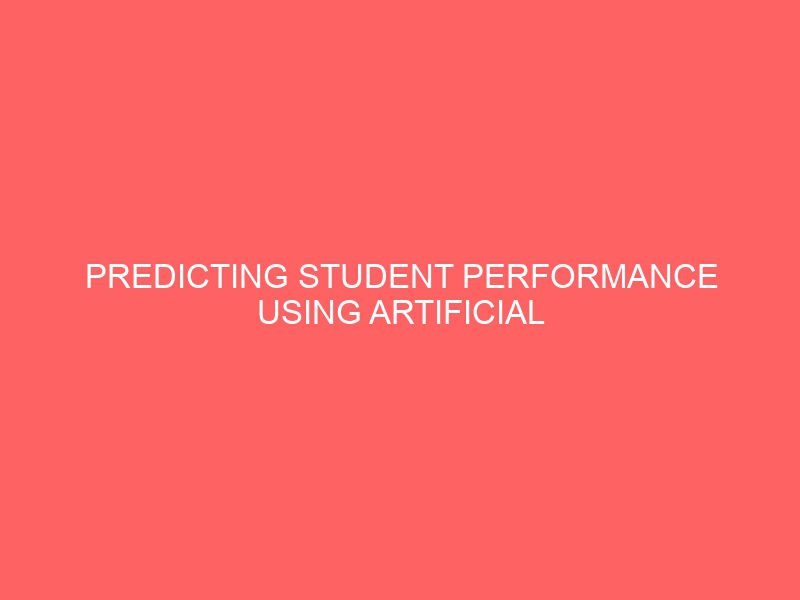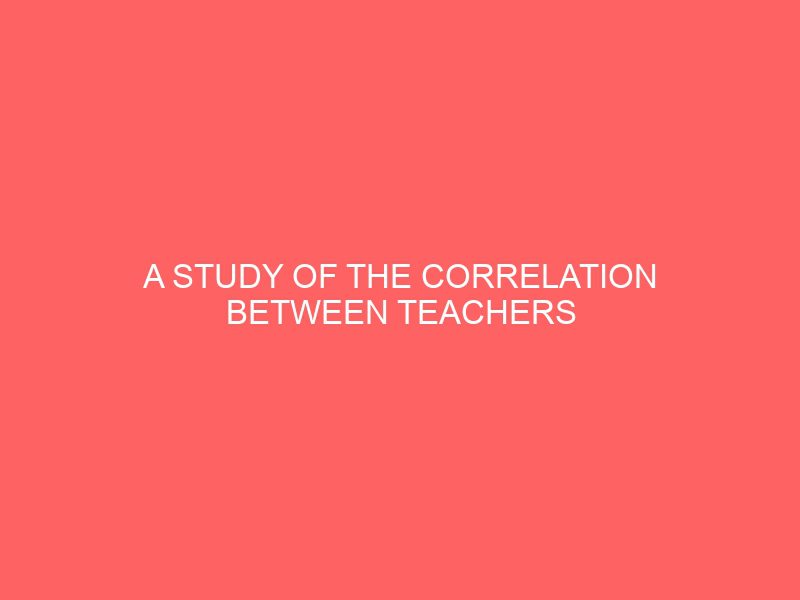CHAPTER ONE
1.0 INTRODUCTION
This research is on predicting student performance using artificial neural network a study of fountain university student. During the last few years, the application of artificial intelligence in education has grown exponentially, spurred by the fact that it allows us to discover new, interesting and useful knowledge about students. Educational data mining (EDM) is an emerging discipline, concerned with developing methods for exploring the unique types of data that come from educational context. While traditional database queries can only answer questions such as ”find the students who failed the examinations”, data mining can provide answers to more abstract questions like ”find the students who will possibly succeed the examinations”. One of the key areas of the application of EDM is the development of student models that would predict student characteristics or performances in their educational institutions. Hence, researchers have begun to investigate various data mining methods to help educators to evaluate and improve the structure of their course context.
The main objective of the admission system is to determine candidates who would likely do well in the university or can perform well within the academic year or to produce students of high grade and intelligence. The quality of candidates admitted into any higher institution affects the level of research and training within the institution, and by extension, has an overall effect on the development of the country itself, as these candidates eventually become key players in the affairs of the country in all sectors of the economy.
Recently, however, there has been a noticeable slide in the quality of graduates of some Nigerian universities. The inadequacies of the present university admission system, among other factors, have been blamed for this decline. Due to the increasing gap between the numbers students seeking admission and the total available admission slots, there has been a corresponding increased pressure on the process. This pressure has lead to rampant cases of admission fraud and related problems.
In Nigeria, students are required to enter secondary school after spending a minimum of six years of Primary Education and passing a prescribed National Common Entrance Examination. A student then spends a minimum period of six years in Secondary School at the end of which he or she takes the General Certificate of Education Examination (GCE), also known as the Senior Secondary Certificate Examination (SSCE) or the Ordinary Level Exams. A maximum of nine and a minimum of seven subjects are registered for in the examination with Mathematics and English Language being compulsory. Nine possible grades are obtainable for each subject; these are A1, A2, A3 (distinctions grades) C4, C5, C6, (credit grades), P7, P8 (pass grades), and F9 (Failure).
Hence this study takes an engineering approach to tackling the problem of admissions by seeking ways to make the process more effective and efficient. Specifically the study seeks to explore the possibility of using an Artificial Neural Network model to predict the performance of a student before admitting the student.
Intuitively one expects the performance of a student to be a function of some number of factors (parameters) relating to the background and intelligence of said student. It is however obvious that it will be quite difficult finding an analytical (or a mathematical) model that may acceptably model this performance/factors relationship. However one practical approach for predicting the performance of a student may be by ‘extrapolating’ from historical data of past students’ background and their associated performances.
The drawback here is the difficulty of selecting an appropriate function capable of capturing all forms of data relationships as well as automatically modifying output in case of additional information, because the performance of a candidate is influenced by a number of factors, and this influence/relationship is not likely going to be any simple known regression model.
An artificial neural network, which imitates the human brain in problem solving, is a more general approach that can handle this type of problem. Hence, our attempt to build an adaptive system such as the Artificial Neural Network to predict the performance of a candidate based on the effect of these factors.
The results of this prediction can also be used by instructors to specify the most suitable teaching actions for each group of students, and provide them with further assistance tailored to their needs. In addition, the prediction results may help students develop a good understanding of how well or how poorly they would perform, and then develop a suitable learning strategy. Accurate prediction of student achievement is one way to enhance the quality of education and provide better educational services (Romero and Ventura, 2007). Different approaches have been applied to predicting student academic performance, including traditional mathematical models and modern data mining techniques. In these approaches, a set of mathematical formulas was used to describe the quantitative relationships between outputs and inputs (i.e., predictor variables). The prediction is accurate if the error between the predicted and actual values is within a small range
1.1 BACKGROUND OF THE RESEARCH
In machine learning and cognitive science, artificial neural networks (ANNs) are a family of statistical learning models inspired by biological neural networks (the central nervous systems of animals, in particular the brain) and are used to estimate or approximate functions that can depend on a large number of inputs and are generally unknown. Artificial neural networks are generally presented as systems of interconnected “neurons” which exchange messages between each other. The connections have numeric weights that can be tuned based on experience, making neural nets adaptive to inputs and capable of learning. For example, a neural network for handwriting recognition is defined by a set of input neurons which may be activated by the pixels of an input image. After being weighted and transformed by a function (determined by the network’s designer), the activations of these neurons are then passed on to other neurons. This process is repeated until finally, an output neuron is activated. This determines which character was read.
The artificial neural network (ANN), a soft computing technique, has been successfully applied in different fields of science, such as pattern recognition, fault diagnosis, forecasting and prediction. However, as far as we are aware, not much research on predicting student academic performance takes advantage of artificial neural network. Kanakana and Olanrewaju (2001) utilized a multilayer perception neural network to predict student performance. They used the average point scores of grade 12 students as inputs and the first year college results as output. The research showed that an artificial neural network based model is able to predict student performance in the first semester with high accuracy. A multiple feed-forward neural network was proposed to predict the students’ final achievement and to classify them into two groups. In their work, a student achievement prediction method was applied to a 10-week course. The results showed that accurate prediction is possible at an early stage, and more specifically at the third week of the 10-week course.
Advising students on their class performance and motivating them in order to improve on their performance is an integral part of every instruction. The mechanisms to achieve the above aim required a technique capable of accurately predicting student achievement as early as possible and cluster them for better academic assistance. According to Lykourentzou et al, (2009), student-achievement prediction can help identify the weak learners and properly assist them to cope with their academic pursuit. Several methods and systems have been developed for the above task, most of which are artificial intelligence-based. For instance, Lykourentzou et al., (2009) estimated the final grades of students in e-learning courses with multiple feed-forward neural networks using multiple-choice test data of students of National Technical University of Athens, Greece as input. The results obtained shows that ANN is 91.2% efficient. Junemann, Lagos, and Arriagada (2007) used neural networks to predict future student schooling performance based on students’ family, social, and wealth characteristics. The aforementioned work focused on predicting the achievement of 15-year-old secondary students on reading, mathematics and science subjects in Berlin.
In the Nigeria context, Oladokun, Adebanjo & Charles-Owaba (2008) applied multilayer perceptron neural network for predicting the likely performance of candidates being considered for admission into Engineering Course of the University of Ibadan using various influencing factors such as ordinary level subjects’ scores, matriculation exam scores, age on admission, parental background etc., as input variables. The results showed that ANN model is able to correctly predict the performance of more than 70% of prospective students.
However, Abass et al., (2011) applied another technique of Artificial Intelligence (AI) i.e., case-base reasoning (CBR) to predict student academic performance based on the previous datasets using 20 students in the Department of Computer Science, TASUED as the study domain. The high correlation coefficient observed between the actual graduating CGPA and the CBR predicted ones also justify the usefulness and effectiveness of AI techniques in this type of task.
In this research work, Artificial Neural Network is used to estimate students’ final grade in the university with a prediction level of 92%.
1.2 STATEMENT OF RESEARCH PROBLEM
Looking into the institution this days, you will discover that 48% of the student are actually performing very low on their academic level, whom if asked to defend his admission status cannot (i.e. sitting for the attitude test), when proper investigation is carried out, findings shows that most of them have their way into the school through bribe or the so called upper hand. Also another issue or problem for this research work is that some of the applied candidates, some are actually sound and capable of performing well when admitted, but because of some factors at the moment or surrounding the student, prevent the student from obtaining or securing his admission into the school. With this little problem I seek to develop a neural network system an artificial one that will solve this problem. Coupled with the stress gone through during the admission and delay in the process that ends up not being done perfect to the standard required.
The observed poor academic performance of some Nigerian students (tertiary and secondary) in recent times has been partly traced to inadequacies of the National University Admission Examination System. It has become obvious that the present process is not adequate for selecting potentially good students. Hence there is the need to improve on the sophistication of the entire system in order to preserve the high integrity and quality. It should be noted that this feeling of uneasiness of stakeholders about the traditional admission system, which is not peculiar to Nigeria, has been an age long and global problem. Kenneth Mellamby (1956) observed that universities worldwide are not really satisfied by the methods used for selecting undergraduates. While admission processes in many developed countries has benefited from, and has been enhanced by, various advances in information science and technology, the Nigerian system has yet to take full advantage of these new tools and technology. Hence this study takes an scientific approach to tackling the problem of admissions by seeking ways to make the process more effective and efficient. Specifically the study seeks to explore the possibility of using an Artificial Neural Network model to predict the performance of a student before admitting the student.
1.3 OBJECTIVES OF THE STUDY
The primary aim of my research work is to develop an artificial neural network system that will be capable of predicting student performance.
Some other objectives which I will be covering in this research work are as follows:
- A system that will enhance the admission process of this institution in terms of admitting the right student into the institution.
- An easy and friendly user interface ANNs which will allow fast operation and analysis of student output.
- To determine some suitable factors that affect a student’s performance.
- To model an artificial neural network that can be used to predict a candidate’s performance based on given pre requirement data given to it.
1.4 SIGNIFICANCE OF THE STUDY
This study will educate on the design and implementation of Artificial Neural Network. It will also educate on how Artificial Neural Network can be used in predicting student’s academic performance.
This research will also serve as a resource base to other scholars and researchers interested in carrying out further research in this field subsequently, if applied will go to an extent to provide new explanation to the topic
Also the system is essential to be developed and implemented in this institution, its significant will promote the image of this university, help the institution in making the proper decision as to whom to admit or knowing ones capability and performance, implementing this system will encourage any applicant to study in the best atmosphere so as to bring the best out of him before seeking for admission into this institution. The chances of frauds, briberies and corruption will be reduce ass each student will be tested be the system and not human. The new system saves and reduce cost of carrying admission test or grading student performance.
1.5 SCOPE OF THE STUDY
The research is limited or only covers on the use of artificial neural network in predicting student performance on their academic using fountain university Ogun State Nigeria. Also, the simulation of the artificial neural network will be done using a data of five years period and learning skills.
1.6 LIMITATION OF THE STUDY
During the course of performing/researching this project work, the researcher encountered a lot of challenges as well as opposition which ranges from financial constraints, time factor, sourcing of material etc. this factors in their own ways, slowed down the speedy progress of this work that resulted to the researcher not being able to finish the research work on time as is required
1.7 DEFINITION OF TERMS
NONPROFIT ORGANIZATION: A nonprofit organization or organization surplus income to the organization’s shareholders














